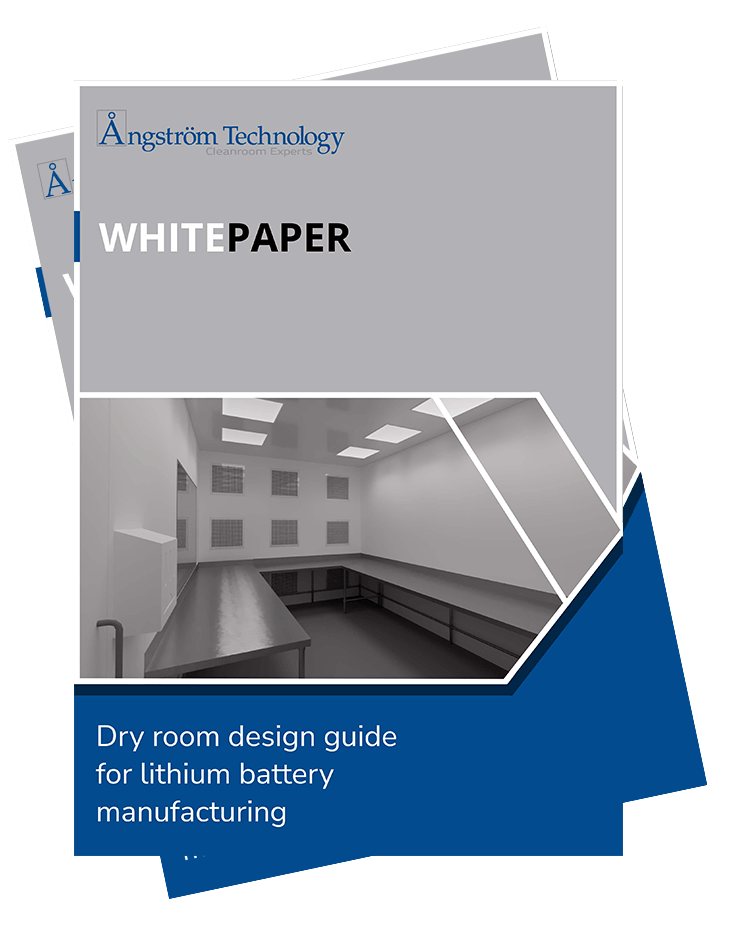Many materials and processes used in battery production are susceptible to moisture damage. For that reason, humidity control is critical in a battery dry room. The experts at Angstrom Technology can create a stable low dewpoint production environment to meet your requirements. In this blog post, we explain how.
Battery dry room construction
Battery dry rooms require a constant supply of ultra-dry air to create and maintain low-humidity conditions for the R&D and production of solid-state and lithium-ion batteries.
We can develop an energy-efficient dry room to protect your critical process in any of the following applications. We do this by combining airtight envelope systems, dehumidification systems, and HVAC design.
Small-scale battery research | Pilot plants | Mega / Giga-factory |
| Single-zone facilities for testing the chemicals and processes during battery R&D. | Multi-zoned facilities for scaling up production to manufacture at volume. | Large-scale battery production facilities for high-volume battery production. |
Battery dry room manufacturers
As battery dry room facility manufacturers, we deliver complete dry room systems. Working with specialist humidity control partners, we provide bespoke solutions that include industry-leading energy-efficient HVAC systems.
A typical clean room environment operates at 20.0°Cdb, 50% Relative Humidity — which is a dewpoint of 9.3°Cdp. Due to the materials’ sensitivity in the process, solid-state battery dry rooms can require control to minus 40.0°Cdp at the room’s exit point. A lower dewpoint of minus 50.0°Cdp is required for Lithium-ion battery dry rooms, and the next generation may have even tighter requirements. The battery chemistry may need the environment to reach minus 80.0°Cdp at the point of supply into critical areas, such as Electrolyte Fill.
Look at how we can custom-build your perfect battery dry room.
Footprint & zones
Establish a suitable layout for your process, featuring multiple zones, each with the optimum dew point temperature and ISO class.
Dehumidification systems
Single or multi-rotor low dewpoint AHU options to suit your budget, space, and specification needs.
Internal airflow distribution methods
Horizontal unidirectional airflow with a supply and return air plenum or a high-level distribution system with uni or non-unidirectional airflow.
Airflow modelling
Using Computational fluid dynamics (CFD) studies to verify HVAC design with equipment and furniture layouts.
Scalable HVAC designs
With specialist AHUs designed for deployment in battery facilities, airflows range from 2,000 m³h to 50,000 m³
Energy-efficient design
Airtight envelope systems and recirculated air manage energy efficiency.
Battery dry room design & build projects with Angstrom Technology
As Angstrom Technology are cleanroom specialists, our dry rooms can also achieve ISO classification. Not only that, but they can also meet any applicable international engineering and building standards and regulations.
We’ve developed proven envelope solutions and reliable cleanroom HVAC designs for many applications. The Angstrom Technology group pride ourselves on our in-house expertise and capability to deliver over 100 cleanrooms annually across America, the UK, and Europe.
Tell us about your new dry room project!
Whitepaper: Dry room design guide for lithium battery manufacturing
DOWNLOAD OUR HANDY GUIDE:



